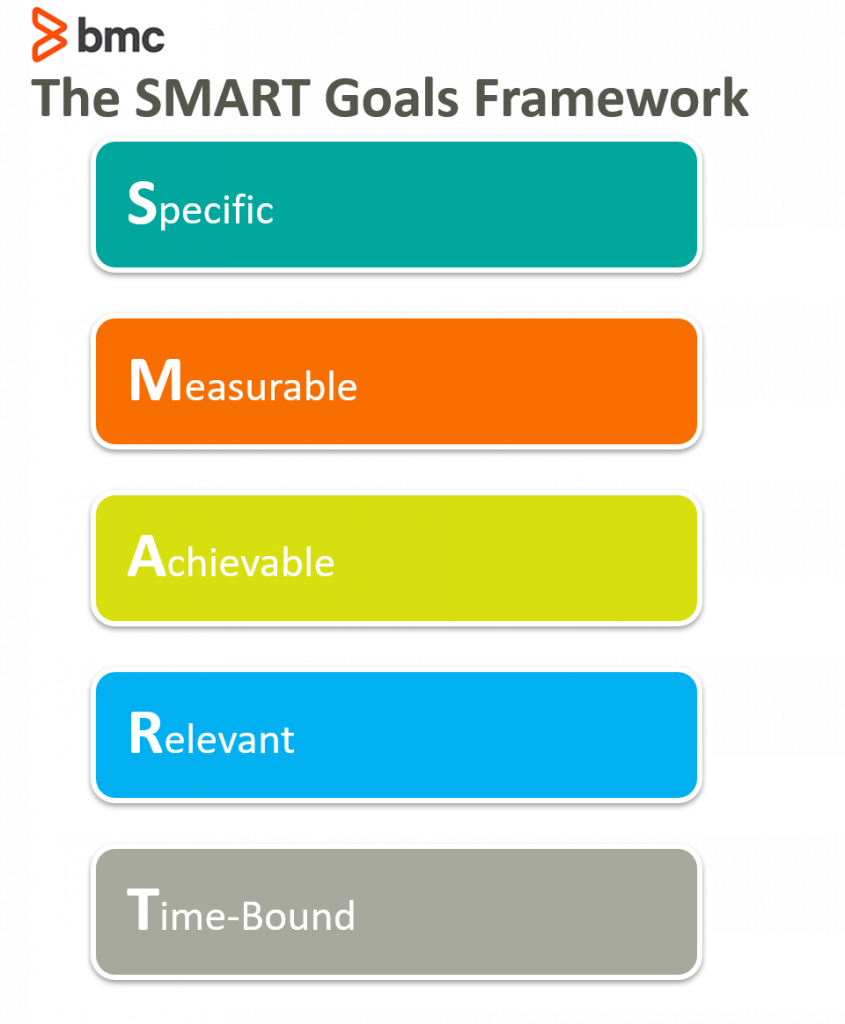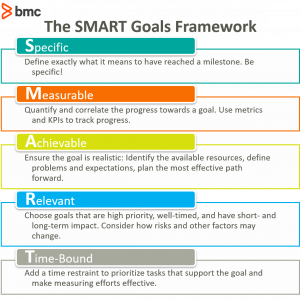The SMART goals framework helps define and plan for achievable outcomes. The idea is to define meaningful and impactful goals that are clear and can be realized within the available means. The common interpretation of the acronym is:

You can certainly apply the concept of SMART goals to any aspect of your life. Companies, however, frequently use the SMART framework to identify organizational objectives and manage employees. The approach helps eliminate ambiguities and guesswork in setting goals, making progress toward goals a process that can be measured.
Whether for personal or workplace use, the SMART approach can help! In this article, we’ll look at SMART goals, real examples, and how to apply SMART principles to make sure your targets are achievable.
The SMART Goals approach
Here are the five factors to consider when creating SMART goals:
S = Specific
Target a specific objective. Define exactly what it means to have reached a milestone. Create a holistic view of the goal in front of you. In practice, this can be achieved by answering the following aspects of defining a specific goal:
- What needs to be accomplished? This could be a detailed description of the objective.
- Who is responsible for the necessary tasks?
- Where is it located? This could be an event or location that must be identified as a detailed specification of the goal.
- When should the target be reached? Setting a timeframe is a critical component of SMART goals, covered further in the Time-Bound section, below.
- Which requirements should be fulfilled? Account for all obstacles that must be addressed in achieving the goals.
- Why is this goal important? Identifying and understanding the motivation behind a goal makes it more achievable.
| Examples | |
| Non-specific goal | We must improve customer satisfaction. |
| Specific goal | Our tech support must register a 20% improvement in customer satisfaction based on a post-support survey with customers within the next six months. |
M = Measurable
The progress toward a goal must be quantifiable and correlate with the objectives. It should be tracked on a measurable scale using appropriate KPIs and metrics. You may not celebrate until you meet your final objectives—but each milestone brings you closer toward success. By establishing goals that are measurable, you can identify missed targets and take corrective measures as circumstances change. Importantly, you can find potential performance lapses before it’s too late.
Once the finish line is reached, you can evaluate the historical performance and plan for future improvements. This means that right metrics should be defined to track the progress toward SMART goals. In the domain of enterprise IT, where all business operations are data-driven, getting the metrics strategy right is challenging; choosing wrong metrics can be costly.
Of course, as with any measurement, it’s important to measure goals using metrics that provide accurate and realistic views of progress without generating an overwhelming deluge of misleading information.
| Examples | |
| Non-measurable goal | We need to make our mobile app more popular. |
| Measurable goal | We must reach 1 million app downloads by the end of the year 2020 while maintaining 99.999% service uptime for 80% of the userbase. |
A = Achievable
Goals are likely to be achieved if they are realistic, practically possible, and viable based on available resources. An empowering goal can be broken down into attainable milestones. At every progressive step, the end-target appears to be closer to reality—more and more achievable. In contrast, the journey toward an impossible goal causes demotivation at every hurdle. That’s why it’s so important to identify limitations that may impede your goal.
Following a strategic and systematic approach can make goals achievable:
- Identify the resources available to you
- Define the problems and expectations
- Plan the path that will lead you toward success most effectively
It’s also important to understand that circumstances change. A target that’s not achievable today, can be practically within your grasp if the necessary skills and tools are acquired. When defining goals that are practically achievable, it is also useful to understand how you can push your boundaries and make the impossible possible.
| Examples | |
| Non-achievable goal | We must prevent all IT outages on our servers. |
| Achievable goal | We must migrate our mission-critical workloads to a reliable private cloud service that guarantees 99.999% service uptime at comparable Total Cost of Ownership of the OpEx model. |
R = Relevant
When resources are limited, you must focus on goals that are most impactful and require immediate attention—both in the short- and long term. It is always possible to achieve many targets, but all targets consume resources and deliver a different outcome. Progressive organizations identify the targets that are most relevant to their vision, strategy, and long-term business growth.
In order to determine whether a goal is relevant, consider the following decision criteria for a goal:
- Is it required? What’s the priority?
- Is it the right time?
- What’s the short and long-term impact of pursuing this goal?
- What are the risks involved and how are circumstances expected to evolve over time?
| Examples | |
| Irrelevant goal | We should double our marketing budget to advertise the stability and performance of our app in the market. |
| Relevant goal | We must reduce data leaks, network infringement and IT outage incidents by 50% with an additional IT security budget of $5 million per annum. |
T = Time-Bound
Many goals are achievable if allocated enough time. However, the results may not be impactful if not reached in appropriate time. Adding the constraint of a time duration allows you to prioritize tasks in your periodic routine. Daily tasks should not affect long-term goals. Similarly, ignoring routine tasks can add to the backlog that can impact your schedule plan in the future.
Time-oriented goals also make the progress trackable over the duration of assignment. Progress relative to time spent or time remaining delivers insightful information on past progress and how future plans should be changed in response to the current pace.
| Examples | |
| Non-time-bound goal | We should double our revenue. |
| Time-bound goal | We must increase the rate of customer acquisition by 10% within the next six months by investing in a thorough marketing campaign designed for focused target groups. |
SMART goals for digital transformation
It’s easy to remember the SMART framework whenever you need to establish goals that you need to achieve.

Additional resources
For more on developing goals and choosing metrics and KPIs that help you achieve these goals, check out these BMC Blogs:
- Choosing IT Metrics That Matter
- ITSM ROI: Improve Productivity, Cost Savings, and Competitiveness via Enterprise ITSM
- Pitfalls of Choosing the Wrong IT Service Desk Metrics
- What is Digital Transformation?
- Digital Transformation: The Good, Bad, and Ugly







